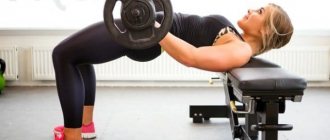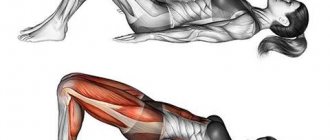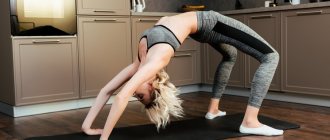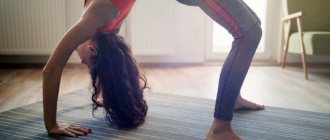The bridge exercise is a closed-chain bodyweight exercise that increases hip extensor strength and helps maintain trunk stability. It is often prescribed to patients with low back pain because it indirectly increases the activity of the core stabilizer muscles, such as the internal and external obliques and the erector spinae.
People with lower back and hip problems are taught to perform the bridge while lying on their back, lifting their pelvis off the floor. This exercise is especially useful for improving pelvic movement and strengthening the lower back and hip extensors, as well as improving motor control in the lumbopelvic region.
HOW TO INCLUDE THE BRIDGE EXERCISE INTO YOUR TRAINING PROGRAM
Start first with simple pelvic lifts, gradually increasing the time you hold the body at the top point.
The bridge exercise is the simplest for the core muscles, and allows you to learn to feel muscle tension in the central part of the body. During its execution, a burning sensation should appear in the gluteal muscles. If your thigh muscles begin to cramp, you need to rest and stretch.
View the entire set of abdominal exercises
If you have any questions about the material you have read, you can ask our specialists via the contact form or SIGN UP FOR A FREE CONSULTATION. We will be happy to answer everyone!
Strengthening the spine with the “Bridge” exercise
The spinal cord is an important part of the human body, which is why training the muscular corset of the back, as well as the flexibility of the spine, gives great benefits to people involved in sports. After all, as you know, damage to the spine can deprive a person of the ability to move.
The spinal column serves as protection for the bone elements and ensures the safety of the spinal cord. Moreover, thanks to the elasticity of the muscles, the spine is able to move, bend and straighten. Regular exercises will ensure flexibility of the spine, which allows a person to fully move and control their movements, and also protects the body from diseases such as osteoporosis, atrophy, and neuropathic pathology.
Pros and cons of the Bridge exercise
By doing workouts 2-3 times a week, you can achieve the following results:
- Increase your back flexibility, thereby improving your posture and strengthening your back muscles.
- Reduce the risk of spinal wear.
- Reduce the likelihood of vertebral displacement.
- Eliminate the possibility of calcium deposits in the area of the cervical vertebrae.
- Improve coordination of movement and functioning of joints.
Despite the large number of benefits, do not think that this exercise can solve any problem associated with back pain. Improper execution of exercise elements can lead to a lot of harm. Severe stretching can lead to painful sensations that will prevent you from exercising for some time.
Before you start doing the exercises, you need to consult a specialist, as he has contraindications. The main diseases are lumbar intervertebral hernia and spinal protrusion.
Why the exercise lost its popularity
Today, there are rarely people who can easily perform a “bridge,” since most people prefer training their arms and abdominals. Despite the fact that instructors in fitness clubs recommend doing exercises for all muscle groups, the “bridge” has lost its popularity. And this is very sad, because the exercise works well not only the back muscles, but also the buttocks and abdomen. The main reason many people refuse this exercise is the difficulty of performing it. It requires support and doesn't fit well with a mix of other exercises.
Instructions for performing the “bridge”
To perform the exercise, you must follow 4 basic rules:
- The ideal execution is considered to be maximum back arching, but many beginners with weak muscles find it difficult to arch their back.
- The correct position of the buttocks is one of the most important conditions. It is necessary to raise the pelvis high, the level of the pelvis should be much higher than the level of the lowered head. Otherwise, the exercise will not be performed correctly.
- Arms and legs should be as straight as possible. To achieve this result, you need to develop the joints, since it is very difficult to take such a position.
- When performing the exercise, you need to breathe evenly and deeply. This will reduce the load on the diaphragm, and breathing will not be interrupted. Experts believe that proper breathing is the key to success.
It is extremely difficult to stand on the “bridge” on the first try; for this you need to prepare your body and start exercising while lying on the floor. However, over time, when your spine gains flexibility, it will be enough to simply tilt your arms back to bend.
5 reasons why you should do the bridge exercise every day
There are many benefits to strengthening the muscles of your back, buttocks and abs. These include not only a beautiful body, on which any clothing will seem ideal, but also a feeling of lightness and health, which increases vitality and strengthens human health.
5 main reasons why you should start mastering the technique of performing the “bridge” exercise:
- Significant reduction in pain in the back and knees. During training, the muscles of the buttocks and subcutaneous tendons are very rarely involved. Usually, when doing household chores and any physical activity, the quadriceps do all the work. Ultimately, relying on one muscle group leads to overexertion and can lead to joint and back pain. In turn, the “bridge” compensates for the work of the quadriceps and engages the posterior muscle chain.
- Sports results will become much better. During the exercise, an important factor is to strengthen the gluteal muscles and core. Strengthened muscles help athletes be stronger, faster and taller than others, in addition, the mobility of a person's joints improves, and household chores do not seem so difficult.
- The clothes fit perfectly. Agree that on a figure with a toned buttocks and a flat stomach, any clothes will look great. Which undoubtedly increases self-confidence and attractiveness. The most noticeable are the strengthened muscles of the buttocks. Using extra weight when training is an advantage, but don't go overboard.
- Development of the core muscles. They are located deep inside the body, their function is to support the spine. By training these muscles, you can provide strong support to the spine.
- Majestic posture and healthy body. Regular exercise will help you keep your back straight throughout the day, regardless of prolonged sitting or standing. The technique is considered quite safe for people with back pain. Recommended for people who lead a sedentary or sedentary lifestyle.
Author: K.M.N., Academician of the Russian Academy of Medical Sciences M.A. Bobyr
ADDITIONAL INFORMATION ON THIS TOPIC
How to pump up your abs Intensive training, energy deficit and food composition play a decisive role in the desire to pump up your abs. Abdominal exercise machines Using abdominal exercise equipment does not provide any benefits in the fight against excess weight and building abdominal muscles. Abdominal training: mistakes For many people, abdominal training is the main goal of exercise. In this article, we want to talk about what mistakes are made when working on the press and about possible options for correcting them. How to get a flat stomach In order to have a flat stomach, you should consider factors that may prevent you from achieving this goal - sleep, alcohol, training certain parts of the body, stress. Why excess weight does not go away In this article, we set ourselves the task of drawing your attention to the most common “mistakes” that occur in those who want to lose weight.
Bridge exercise for lower back pain
This exercise is most often prescribed to patients suffering from lower back pain. However, it is known that the plank also has a number of advantages.
The plank, like the bridge, improves proprioception of the lumbar spine (moreover, the plank activates the core muscles to a greater extent than the bridge). In addition, the plank helps to significantly strengthen the external and internal oblique abdominal muscles, as well as the transverse abdominal muscle.
Thus, not only is the bridge necessary for patients with low back pain, the plank also plays an important role and is a mandatory exercise to include in the rehabilitation program of such patients.
Benefits of exercise
The benefits of bridge exercises are not limited to the positive effect on appearance. This stance has powerful healing potential.
Famous oriental healers of antiquity believed that the health and longevity of a person depended on the condition of the spine. Their correctness is confirmed by Indian yogis who practice exercises, most of which are aimed specifically at developing flexibility and strengthening the spinal column.
Backbends develop spine flexibility and strengthen the deep back muscles. The cartilage tissue of the vertebral discs receives the necessary substances not from the blood, but from the synovial fluid. Active movements of the vertebrae are necessary for its influx. Due to the low mobility of the spinal column, its cartilage does not receive enough nutrition, and degenerative changes in cartilage tissue begin at a young age.
Bending backwards causes the intervertebral discs to compress and stretch, acting like an internal massage. As a result, an influx of synovial fluid is ensured, and the vertebrae are actively supplied with necessary substances. As a result, metabolic processes in cartilage tissue are accelerated and regeneration processes are launched.
A strong and healthy spine is especially important during strength training, because this type of load is very traumatic. Including the bridge in the training program of athletes and bodybuilders serves as an excellent prevention of back injuries.
In addition to the beneficial effect on the spine, regularly standing on a bridge helps expand the chest, increase lung capacity, and stretch the abdominal muscles. Due to the unusual position of the head, the vestibular apparatus and cerebral vessels are trained, which serves as the prevention of cerebral circulatory disorders.
The benefits of this exercise cannot be overestimated. In addition, being able to easily stand on a bridge from a standing position and rise from it, you can attract admiring glances in the gym, which improves your mood and motivation.
Benefits of the bridge
Therefore, purely mechanical work on these areas has an effect on the functioning of the body. Such information is known and is not a secret, for example, exercises for the neck help the functioning of the thyroid gland, and working out the thoracic region improves the functioning of the thymus and heals the heart and lungs.
The peculiarity of the bridge pose is that this pose allows you to open all the chakras, arch and increase stimulation of all important areas of the body.
Moreover, such an impact is performed at a time. Accordingly, the body receives a powerful multifaceted impulse and a charge of vigor, and a general healing effect is performed.
Execution technique
The person is in a supine position, with the knees bent and the feet placed on the floor almost close to the buttocks; you need to lift your pelvis up.
This exercise consists of several elements:
- Hip extension.
- Lumbar extension.
- Posterior pelvic tilt.
Variations
- With a posterior pelvic tilt.
- With a straight leg raise.
- With a straight leg raise and contraction of the gluteal muscles.
Research results
- The activity of the corresponding muscles during the execution of various bridge variations (including planks) was assessed by Kong YS et al. in 2013. The authors concluded that planks were more effective at strengthening the core muscles.
- A 2022 study by Jeong-Oh Yoon et al found that bridging on an unstable surface or with a single leg lift stimulated muscle activity such as the internal oblique and rectus abdominis. At the same time, no significant increase in activity was observed in the multifidus muscle and the erector spinae muscle. The internal oblique muscle is indirectly connected to the lumbar calf through the thoracolumbar fascia, so its activation stimulates the lower back muscles. It should be noted that rectus abdominis muscle activity increases on the side of the elevated leg (e.g., raising the right leg increases the activity of the right rectus abdominis muscle).
- Chan-Myeong Kim et al. (2018) showed that the activity of the external oblique and erector spinae muscles increases with internal rotation of the hip, while the gluteus maximus muscle is significantly activated with external rotation of the hip.
- Performing a bridge on an unstable surface increases the activity of the deep abdominal muscles, particularly the transverse abdominis and internal oblique (compared to performing this exercise on a stable surface).
- To reduce excessive lumbar lordosis, the abdomen can be pulled in during the bridge exercise. While performing the side plank (side bridge), you can exhale as much as possible, this also increases the activity of the abdominal muscles (compared to a calm exhalation).
Bridge and flat stomach
Thus, if you do the bridge often enough and regularly, the effect will be positive for the whole body. However, it is possible to perform the exercise in such a way as to achieve a positive effect in the abdominal area.
The impact here is multidimensional:
- muscles are stretched;
- organs are built;
- trophism improves;
- skin tightens.
In general, a rather pleasant shape of the abdomen is created and it simply becomes more beautiful. Even if a layer of fat remains there, the appearance will still be different.
Note. It is quite normal for female anatomy to have a slightly convex lower abdomen, with a little more fat there.
If you perform cyclic exercises with a large number of repetitions, then you can get additional fat burning and shape your tummy more efficiently.










